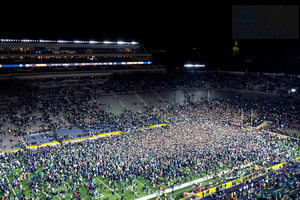 "
"
Nov. 5 was a great day for Notre Dame football fans. Notre Dame started off strong against No. 4 Clemson, scoring the first touchdown of the game roughly six minutes into the first quarter. The Irish didn’t look back, romping to a 35-14 triumph.
This wasn’t just like any other game for Irish fans. It was the first time playing Clemson on home turf since Notre Dame’s victory over the Tigers on Nov. 7, 2020 in double overtime. Clemson was ranked No. 1 at the time, and, immediately after the unexpected win, students stormed the field.
Going into this recent game against Clemson, there was a general agreement among students that they would rush the field again if the Irish won. Senior Maria Chapman was able to experience the post-win field storming both times. “I think what was so exciting was knowing that we were going to rush the field,” she said. This hope increased fan engagement, keeping those who might normally leave before the end of a game there until the final moments. As the fourth quarter neared its end, students slowly began to push towards the bottom of the stands, ready to get down to the field after the final snap.
When Notre Dame beat Clemson in 2020, students were spread out in the stands to practice social distancing due to the COVID-19 regulations. While there was a lot of criticism in the media about many students rushing the field and being in such close proximity during a pandemic, the limited capacity crowd made it physically easier for students to rush onto the field quickly.
In the 2022 matchup, the student section was nearly full, so “rushing” the field was a much slower process. Chapman, who was sitting in the upperclassman section, said that “the ushers wouldn’t let (them) pass,” which she described as a “bummer.” “But, apart from that,” she said, “(the experience) was amazing.”
In anticipation of field rush, the Notre Dame band, which sits at the front of the freshman section during every home game, was told not to move while everyone made their way down the bleachers. Brooke Duncan, a trumpet player in the Notre Dame band, said that beating Clemson in 2020 is one of her favorite memories, but “the difference this time was (that students) were packed into the stadium with nowhere to move.” Immediately after the freshmen started lining up to storm the field, she knew that her section could be in a lot of danger if people started pushing. It was “terrifying,” she said, to see the concern on her friends’ faces. She witnessed a freshman getting trampled before the band pulled her into their section to keep her from getting hurt. Another member of the band witnessed another freshman girl break her leg. Duncan said the girl reportedly “fell forward over the bleachers, and enough people fell on top of her leg with the force to break it.” Duncan described the win as “bittersweet.” It wasn’t worth the fear of her friends getting injured while everyone tried to storm the field all at once.
While storming the field was a big deal for the students and fans, it was also impactful for the players. Senior running back Chris Velotta was able to experience the field storming from the turf both this season and in 2020. Velotta reflected on the 2020 Clemson game, recalling that the stadium was the loudest it had ever been in his career, despite the limited attendance. While Velotta said that “this year, the field storm was awesome yet again,” he felt that “nothing beats 2020 for two reasons: one, the game was far better and more intense, and two, (the team) could actually move around in the mosh pit after because there weren’t as many people.”
Storming the field is not a typical post-win occurrence. Barring certain obstacles — from a pandemic to broken limbs — the two field rushes are memories Notre Dame students will share for a lifetime